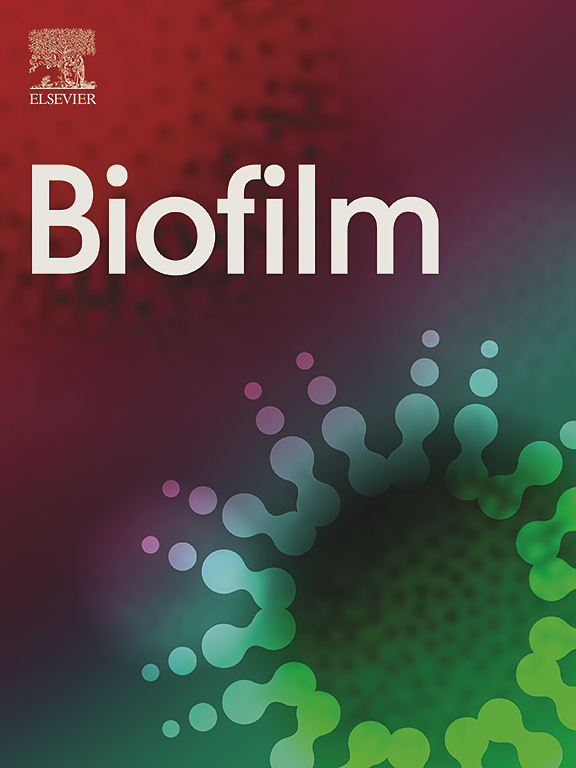Aqueous extracts of Moringa oleifera and Cinnamomum cassia as promising sources of antibiofilm compounds against mucoid and small colony variants of Pseudomonas aeruginosa and Staphylococcus aureus
IF 4.9
Q1 MICROBIOLOGY
引用次数: 0
Abstract
Bacterial biofilms formed by Staphylococcus aureus and Pseudomonas aeruginosa pose significant challenges in treating cystic fibrosis (CF) airway infections due to their resistance to antibiotics. New therapeutic approaches are urgently needed to treat these chronic infections. This study aimed to investigate the antibiofilm potential of various plant extracts, specifically targeting mucoid and small colony variants of P. aeruginosa and S. aureus and strains. Moreover, it aimed to gain insights into the mechanisms of action and the potential phytochemicals responsible for antibiofilm activity. Solid-liquid extractions were performed on seven biomasses using water and ethanol (70 and 96 %) under controlled conditions, resulting in 21 distinct plant extracts. These extracts were evaluated for extraction yield, antioxidant activity, phenolic content, chemical composition by HPLC-TOF-MS, and antibiofilm activity using a 96-well plate assay, followed by crystal violet staining, bacterial adhesion assessment, and brightfield microscopy. Our findings revealed that aqueous extracts exhibited the highest inhibition of biofilm formation, with cinnamon bark and moringa seeds showing strong antibiofilm activity against both bacterial species. Brightfield microscopy confirmed that these extracts effectively inhibited biofilm formation. Chemical analysis identified key bioactive compounds, including moringin, benzaldehyde, coumarin, and quinic acid, which likely contribute to the observed antibiofilm effects. Recognizing that the antibiofilm properties of moringin, a common compound in both moringa seed and cinnamon bark extracts, remain underexplored, we conducted potential target identification via PharmMapper and molecular docking analyses to provide a foundation for future research. Computational analyses indicated that moringin might inhibit aspartate-semialdehyde dehydrogenase in P. aeruginosa and potentially interact with an unknown target in S. aureus. In conclusion, moringa seed and cinnamon bark extracts demonstrated significant potential for developing new therapies targeting biofilm-associated infections in CF. Further studies are needed to validate the computational predictions, identify the bacterial targets, and elucidate the precise mechanisms behind moringin's antibiofilm activity, which is likely the potential key contributor to the observed activity of the moringa and cinnamon bark extracts.
辣木和肉桂水提物作为抗铜绿假单胞菌和金黄色葡萄球菌黏液和小菌落变异的有前景的抗生素膜化合物来源。
金黄色葡萄球菌和铜绿假单胞菌形成的细菌生物膜由于对抗生素的耐药性,对治疗囊性纤维化(CF)气道感染提出了重大挑战。迫切需要新的治疗方法来治疗这些慢性感染。本研究旨在研究各种植物提取物的抗生物膜潜力,特别是针对铜绿假单胞菌和金黄色葡萄球菌及其菌株的粘液样和小菌落变体。此外,它旨在深入了解作用机制和潜在的植物化学物质负责抗生物膜活性。在控制条件下,用水和乙醇(70%和96%)对7种生物质进行固液萃取,得到21种不同的植物提取物。通过HPLC-TOF-MS和96孔板法分别对这些提取物的提取率、抗氧化活性、酚类含量、化学成分和抗生物膜活性进行评估,然后进行结晶紫染色、细菌粘附评估和明场显微镜检查。我们的研究结果表明,水提物对生物膜的形成具有最高的抑制作用,肉桂皮和辣木种子对这两种细菌都有很强的抗生物膜活性。明场显微镜证实,这些提取物有效地抑制了生物膜的形成。化学分析确定了关键的生物活性化合物,包括辣木素、苯甲醛、香豆素和奎宁酸,它们可能有助于观察到的抗生物膜作用。辣木籽和肉桂皮提取物中常见化合物辣木素(moringin)的抗膜特性尚不清楚,因此我们通过PharmMapper和分子对接分析进行了潜在靶点鉴定,为今后的研究奠定基础。计算分析表明,辣木素可能抑制铜绿假单胞菌中的天冬氨酸-半醛脱氢酶,并可能与金黄色葡萄球菌中的未知靶点相互作用。总之,辣木籽和肉桂皮提取物显示出开发针对CF生物膜相关感染的新疗法的巨大潜力。需要进一步的研究来验证计算预测,确定细菌靶点,并阐明辣木素抗生物膜活性背后的确切机制,这可能是辣木和肉桂皮提取物观察到的活性的潜在关键因素。
本文章由计算机程序翻译,如有差异,请以英文原文为准。
求助全文
约1分钟内获得全文
求助全文

 求助内容:
求助内容: 应助结果提醒方式:
应助结果提醒方式:


